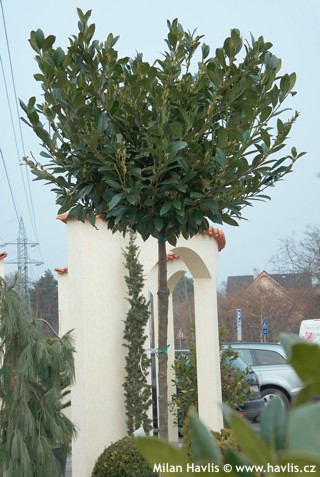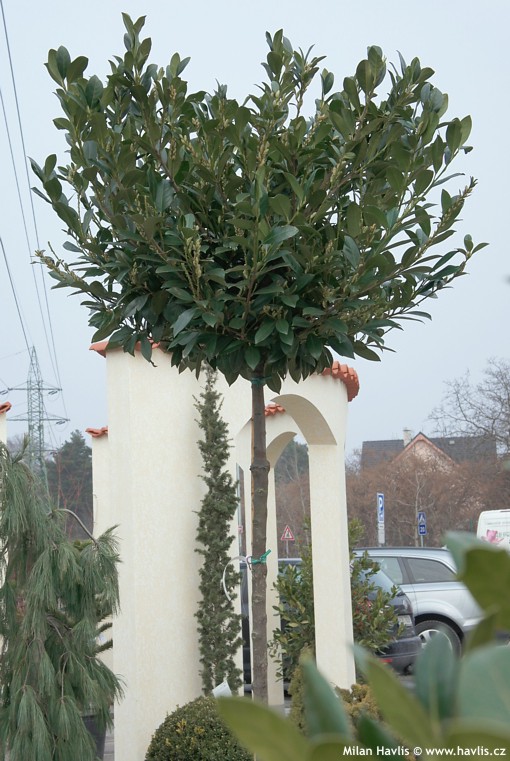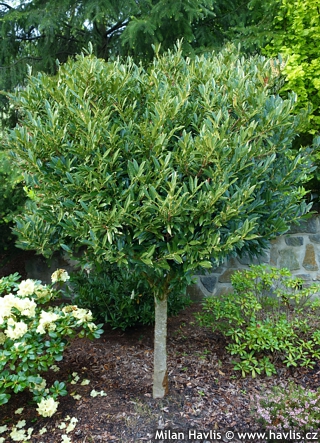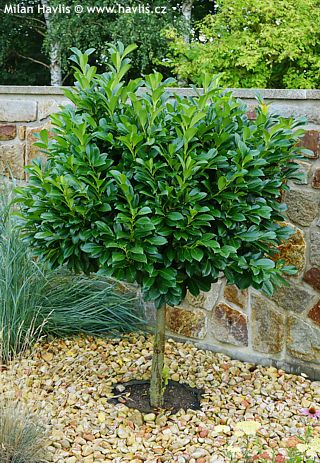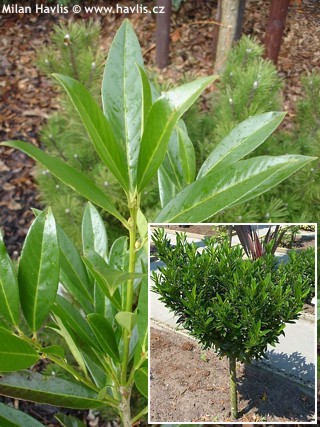Prunus laurocerasus 'MANO' cherry laurel - STANDARD TREE
Prunus
The genus Prunus is quite extensive and, above all, remarkably diverse – it includes around 350 different species, some of which you would hardly place in the same group at first glance. Its representatives occur from Asia through Europe and North Africa to North America. The genus comprises trees and shrubs valued mainly for their abundant and attractive flowering, as well as species with delicious edible fruits, and in this particular case an evergreen species whose persistent foliage becomes especially important during the dormant season, when most other woody plants are leafless. This species is known as cherry laurel (Prunus laurocerasus) and originates from regions around the Black Sea, the Caucasus, and northern Turkey, where it grows in submontane forests and on moist, shaded slopes. Its glossy, leathery leaves resemble those of true laurel, and this similarity that gave rise to its name – lauro‑cerasus, meaning “laurel cherry.” It reached Europe as early as the 16th century and, thanks to its frost hardiness, is today one of the most important evergreen woody plants even in Central European climate.
Cherry laurel was scientifically described in 1753 by Carl Linnaeus in his seminal work Species Plantarum, where it received its still accepted name Prunus laurocerasus. A later, now obsolete name, Laurocerasus officinalis, nevertheless points to a much older history of cultivation and use. A laurel‑like plant identified with cherry laurel is already mentioned by Theophrastus, Dioscorides and Pliny the Elder, who noted its unusual properties. From the leaves of cherry laurel, a distillate known as aqua laurocerasi was prepared and, when used with due caution, employed as a sedative – hence the Latin epithet officinalis, meaning medicinal. Historically and with documentary support, cherry laurel, its introduction, and its first cultivation in European gardens can be traced to the year 1576. This date fits well within the period of diplomatic missions between the Ottoman Empire and the Habsburgs, when seeds, cuttings, and young plants of previously unknown species were brought from Constantinople to Central Europe through networks associated with figures such as the imperial envoy David Ungnad (1530–1600) and the botanist Carolus Clusius (1526–1609). The transfer of newly discovered plants was regarded as a gift equal in value to gold, works of art, or archaeological finds, and represented an important expression of learning, prestige, and practical knowledge of the natural world.
Cherry laurel Mano is a reliable, small to medium‑growing cultivar with a very clean and calm appearance. It stands out for its deep to dark green, highly glossy leaves, which are noticeably pale on the reverse and slightly thinner than those of most other, typically large‑leaved cultivars. The leaves are evergreen, borne upright and densely along the branches, measuring approximately 6×3 cm, and are typically ovate in shape, which distinguishes ‘Mano’ from most other cherry laurels. The shrub grows naturally dense, forms regular tiers, and is richly branched and leafy from the ground up. Therefore, it does not need regular pruning for a nice habit, although it can be shaped without difficulty. At maturity, it usually reaches a height of around 1.5 to 2 m with a similar spread, making it suitable for smaller gardens as well as lower hedges.
Being compact, dense, and obviously so handsome, Mano is a perfect variety to be grown as a tree in half-standard or full standard form. Its ultimate size a summation of the stem size and 2 m (crown size). As every other tree it needs a strong support (staking) for at least three years before it establishes.
The cultivar was created by the Hungarian dendrologist and ornamental plant breeder Dr Elemér Barabits (1921–2003), from a country that has produced many cherry laurel cultivars noted particularly for their higher frost hardiness. During his career, however, Barabits also selected hundreds of cultivars of other woody plants intended for Central European conditions. He achieved international recognition especially through the cultivar Chamaecyparis lawsoniana ‘Globus’ (aka ‘Barabits’ Globe’), now grown throughout Europe and overseas. We are also familiar with the dwarf flowering ash ‘Mecsek’ and a range of compact conifer forms that have become standards in parks and gardens worldwide.
Cherry laurels require moist but well‑drained soil, ideally acidic to neutral and rich in nutrients. They do not tolerate compacted, heavy clay, muddy, or permanently waterlogged soils. They are sensitive to lime in the soil, which most commonly manifests as chlorosis – the leaves lose their green colour and the vein pattern becomes pronounced. Similar symptoms may also occur in cases of nutrient deficiency. In both situations, the application of magnesium sulphate (Epsom salt), organic fertilisers, or adjustment of soil pH towards a more acidic reaction is beneficial. They tolerate pruning of any intensity and respond particularly well to rejuvenation pruning into old wood, from which they readily regenerate. The best time for pruning is in spring after the risk of frost has passed; shaping cuts are carried out in mid‑summer. Because they retain their leaves year‑round – even in winter – and continuously transpire water, they require an adequate supply of moisture. Until a sufficiently deep root system develops, it is advisable to water them at least once a month during dry winters to prevent dehydration and subsequent leaf scorch caused by strong winter sun. To retain moisture and protect against temperature fluctuations, year‑round mulching is strongly recommended. Mano is reliably hardy to min. -25 °C (USDA zone 6), possibly a little more.
Last update 01-04-2013; 29-12-2025

































